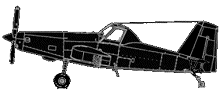
ASN Wikibase Occurrence # 192384
This information is added by users of ASN. Neither ASN nor the Flight Safety Foundation are responsible for the completeness or correctness of this information.
If you feel this information is incomplete or incorrect, you can submit corrected information.
| Date: | Tuesday 27 December 2016 |
| Time: | 15:53 |
| Type: |  Air Tractor AT-602 |
| Owner/operator: | Private |
| Registration: | N602L |
| MSN: | 602-0526 |
| Year of manufacture: | 1999 |
| Total airframe hrs: | 6537 hours |
| Engine model: | Pratt & Whitney PT6A-65ag |
| Fatalities: | Fatalities: 0 / Occupants: 1 |
| Aircraft damage: | Substantial |
| Category: | Accident |
| Location: | Willows-Glenn County Airport (KWLW), Willows, CA -
 United States of America United States of America
|
| Phase: | Landing |
| Nature: | Ferry/positioning |
| Departure airport: | Davis, CA (69CL) |
| Willows, CA (WLW) | |
| Investigating agency: | NTSB |
| Confidence Rating: |
The commercial pilot of the turboprop-equipped airplane departed from the maintenance facility airport following the completion of a 100-hour inspection, which included a compressor bleed valve overhaul. He did not perform an engine run-up or a postmaintenance performance check as recommended by the engine manufacturer but noticed that the engine was “sluggish” during takeoff. Near the conclusion of the 25-minute flight, the pilot initiated a straight-in approach to his destination airport and slightly reduced engine power. Immediately, he heard a “pop” noise and observed a reduction in airspeed. When the pilot advanced the throttle to full power, the engine power and airspeed did not change, and the airplane began to sink. The pilot conducted an off-airport forced landing and the airplane nosed over and came to rest inverted.
Postaccident examination of the engine revealed that the valve seat had not been installed on the overhauled compressor bleed valve. The maintenance manual overhaul procedure requires that the bleed valve seat remain with the engine, which requires that the seat be removed from the old core unit and installed on the replacement or overhauled bleed valve before installing that component on the engine. At the time of the inspection, the inspection facility’s director of maintenance encountered trouble retrieving the maintenance manual for this model engine from the manufacturer’s website and decided to continue the service under the assumption that the bleed valve replacement was similar to another engine model with which he was familiar. The inspection facility submitted the core unit without removing the bleed valve seat, and the valve overhaul facility did not install any seat on the overhauled bleed valve, which was in compliance with the overhaul procedure. The inspection facility then installed the overhauled unit on the engine without the necessary valve seat. Additionally, the inspection facility failed to complete the bleed valve closing check procedure required by the engine manufacturer, which likely would have revealed a malfunctioning bleed valve. Further, the inspection facility reported that they performed an engine run up after completing maintenance, but contrary to required procedures did not record any power settings. Without the power setting data, the investigation was unable to positively determine whether the bleed valve closed properly during the ground test. Additionally, neither the maintenance facility nor the pilot completed the engine manufacturer’s recommended engine performance check after the service was completed.
The airplane was sluggish during takeoff because the engine was not able to achieve full power due to the absence of the bleed valve seat and consequent malfunctioning of the bleed valve. The “pop” sound heard by the pilot when he attempted to increase power during his approach was likely a compressor stall caused by the malfunctioning bleed valve. The malfunctioning bleed valve would have prevented the engine from responding to any additional power demand at this critical moment, and once the engine failed to respond, the pilot likely determined that the airplane would not reach the runway and completed a forced off-airport landing.
Probable Cause: The decision of the maintenance facility mechanic to conduct maintenance without reference to the applicable manufacturer’s guidance, which resulted in the improper reassembly and subsequent failure of the engine compressor bleed valve, which in turn prevented the engine from responding to further power demand at a critical phase of flight. Contributing to the accident was the failure of the maintenance facility’s director of maintenance to ensure that the overhaul was conducted properly and that the required post-maintenance test procedures were accomplished.
Accident investigation:
 |
|
Sources:
NTSB
FAA register: http://registry.faa.gov/aircraftinquiry/NNum_Results.aspx?NNumbertxt=602L
Location
Revision history:
| Date/time | Contributor | Updates |
|---|---|---|
| 28-Dec-2016 17:45 | Geno | Added |
| 11-Nov-2018 08:33 | ASN Update Bot | Updated [Time, Nature, Departure airport, Destination airport, Source, Narrative, Accident report, ] |
Corrections or additions? ... Edit this accident description
The Aviation Safety Network is an exclusive service provided by:


 ©2024 Flight Safety Foundation
©2024 Flight Safety Foundation